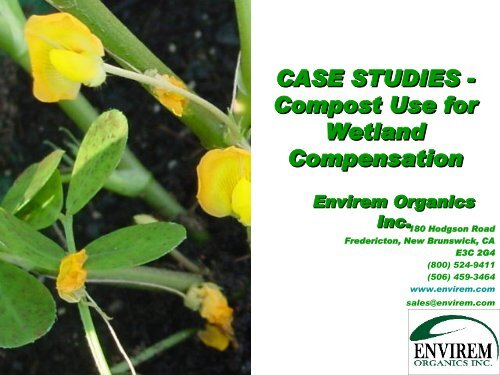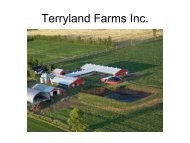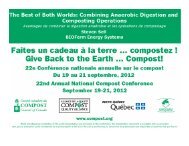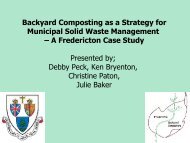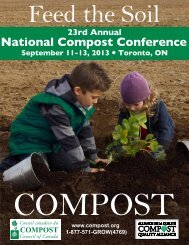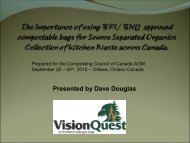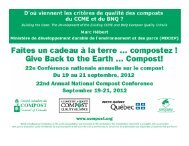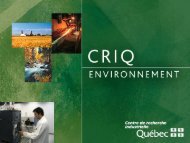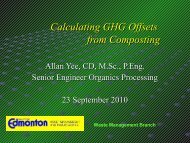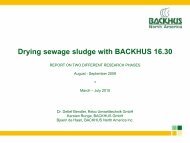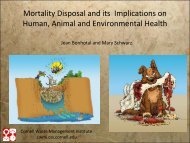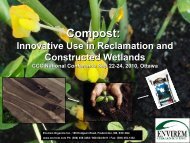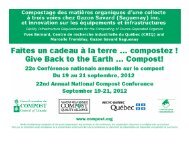Rod Fry, Envirem Organics - Compost Council of Canada
Rod Fry, Envirem Organics - Compost Council of Canada
Rod Fry, Envirem Organics - Compost Council of Canada
- No tags were found...
Create successful ePaper yourself
Turn your PDF publications into a flip-book with our unique Google optimized e-Paper software.
CASE STUDIES -<strong>Compost</strong> Use forWetlandCompensation<strong>Envirem</strong> <strong>Organics</strong>Inc.Inc. 180 Hodgson RoadFredericton, New Brunswick, CAE3C 2G4(800) 524-9411(506) 459-3464www.envirem.comsales@envirem.com
CASE STUDIES - <strong>Compost</strong> Usefor Wetland CompensationContents <strong>of</strong> Presentation1. Wetland Protection versus Development (the stand<strong>of</strong>f)2. Replacing Wetland Functions with <strong>Compost</strong> EnrichedTopsoil and Bio-Retention3. Other benefits <strong>of</strong> <strong>Compost</strong> Amended Soils4. Measurable Results from the Field5. CASE STUDIES for <strong>Compost</strong> Use;a) Northeast US Statesb) Atlantic <strong>Canada</strong>6. Triple Bottom Line Analyses7. <strong>Envirem</strong> <strong>Organics</strong> Inc. compost supply capacity
Wetland Protection versusDevelopment (the stand-<strong>of</strong>f)In the case <strong>of</strong> land development projects, the primary wetlandfunctions that need to be reinstated, replaced or enhanced consist<strong>of</strong> the following1. Wetlands facilitate the earth's surface to absorb and retain stormrainwater events and prevent downstream floods and propertydestruction,2. Wetlands provide a natural protective barrier for infiltration (andcleaning/buffering) and directing surface water from precipitationand snowmelt towards recharging groundwater sources,3. Wetlands support and sustain a wide range <strong>of</strong> flora and fauna whosurvive <strong>of</strong>f the natural wetland ecosystems.
Replacing Wetland Functionswith <strong>Compost</strong> Enriched Topsoiland Bio-RetentionWe believe that the above three key wetland functions can not onlybe reinstated and replaced, but may even be enhanced throughimplementation <strong>of</strong> a simple set <strong>of</strong> SustainableResidential/Commercial Land Development Practices as follows;1. All land areas within the total development footprint must be cappedand re-vegetated with a minimum 6-inch layer <strong>of</strong> organic-matterenriched topsoil (note that organic-matter enriched soils have theability to absorb and retain 1.88 gallons per cubic foot and thatwould far exceed any natural wetland soil type),2. All land areas which must be unavoidably developed directly withinan area <strong>of</strong> exposed surface water <strong>of</strong> a wetland should be replacedwith a constructed wetland providing similar capacities (noteconstructed wetlands can be designed to provide equivalentcapacity through smaller footprint by utilizing greater thickness <strong>of</strong>organic-matter enriched wetland soil and use <strong>of</strong> hydraulic controls),
Replacing Wetland Functionswith <strong>Compost</strong> Enriched Topsoiland Bio-RetentionThese Sustainable Residential/Commercial Land Developmentspecifications, could be implemented through a number <strong>of</strong> potentialavenues.• A Municipality could enact a bylaw for development within municipallands,• Provincial Environment could provide new land developmentguidelines or best management practices for mitigation <strong>of</strong> wetlandalteration,• The current Wetland/Watercourse regulations could be revised toreflect the opportunity to mitigate/reinstate wetland functions usingorganic-matter enriched topsoil and constructed wetlandspractices.These discussion points have been sent to representatives <strong>of</strong> NBEnvironment, Municipalities, Property Developers and otherStakeholders to assist in alleviating the current situation.
Other benefits <strong>of</strong> <strong>Compost</strong>Amended Soils
Rate at which micro-organisms degradecontaminants is influenced by:oxygen, moisture, nutrients, pH,temperature, availability and toxicinhibitorsBiological Mechanisms:biological degradation(hydrolysis/oxidation), cellulardecomposition(molds/fungi/mineralization),adsorption, andvolatilizationSuccess with Organic Pollutants including:Fuels, Explosives, VOC’s and Semi-VOC’sMetals: Arsenic, Cadmium, Lead, Zinc
Measurable Results from theField
Use <strong>of</strong> compost within a constructedwetland soil provides the followingbenefits:• Rapid development <strong>of</strong> wetlandplants and ecosystemcomponents including microbes,insects and wildlife• <strong>Compost</strong> soil media providesincreased precipitation/run-<strong>of</strong>finfiltration rates (>1” per hour)and water holding capacity (2.3gallons/cu.ft)• Increased plant survivability
By introducing dredge spoils into a compost windrow you canbiologically dry the material, stabilize pH and salinity and introduceorganic matter and nutrients providing an excellent manufactured topsoilgrade.
ParametersTopsoilSpecificationTreated SOILS<strong>Compost</strong> AmendedMix 1:1<strong>Compost</strong> AmendedMix 2:1pH 5.5 – 8.0 5.2 7.8 8.1Moisture Content 30-55% 79.1% 43.2% 33.1%Soluble Salts 2.0mmhos (dS) 4.6mmhos (dS) 1.6mmhos (dS) 0.7mmhos(dS)Organic Matter >5% 1.5% 7.2% 9.6%Sand (0.05 – 2.0 mmdia. RangeSilt (0.002 – 0.05 diarange45%-75% 90.3% 67.5% 64.9%15% - 35% 6.1% 19.0% 18.8%Clay (
CASE STUDIES for <strong>Compost</strong>Use;a)Northeast US Statesb)Atlantic <strong>Canada</strong>
Typical Brownfield sites contain “UrbanSoils” characterized by low-level metals(lead, arsenic, cadmium, zinc..etc) and/ororganic pollutants (TPH, PAH, PCE,pesticides …etc.).Real Estate remains under-utilized due toperceived “high treatment costs”.Brownfield soils can be amended withcompost within ex-situ windrows whereby“biological degradation processes” act toreduce contaminants to within acceptableCCME Soil Quality criteria.
Sydney, Cape Breton“Tar-Ponds to Parklands”
Brownfields can also be capped with a 2-4 foot thick layer <strong>of</strong>horticulture-grade “<strong>Compost</strong> Manufactured Topsoil” as inStaten Island NYC.Ecological Landscapers have developed a 10-year ParklandDevelopment Plan with lawns, sportsfields, biking/walkingtrails, and multi-purpose wetland/watercourse habitats.
Amending acidic, low organic-matter disturbedlandscapes with compost will promote vegetationestablishment with long-term “survivability”.Decreases erosion, adheres metals and prevent aciddrainage run-<strong>of</strong>f.Application rates for compost are recommendedbetween 200-400 tonnes per acre to increase organicmatter to >4%.
Amending low fertility and low organic-matter farmlandsoils with compost will sustain crop yields as well asprovide many other environmental benefitsDecreases erosion, adheres nutrients and sustains soilbiology and beneficial micro-organisms for plant health.Application rates for compost arerecommended between 50-100 tonnesper acre to increase organic matter to>2%.
Also the implementation <strong>of</strong> <strong>Compost</strong> Organic-Matter Enriched Vegetated Buffer Strips along farm fieldshave been proven to provide an excellent preventative barrier to nutrient run-<strong>of</strong>f or leachate.
COMAB - TPH DestructionPPM200,000180,000160,000140,000120,000100,00080,00060,00040,00020,00002/25/20083/3/20083/10/20083/17/20083/24/20083/31/20084/7/20084/14/20084/21/20084/28/20085/5/20085/12/20085/19/20085/26/20086/2/20086/9/20086/16/20086/23/200825-Feb 6-Mar 4-Apr 12-May 27-JunDiesel 147,500 29,000 28,000 12,000 6,300Lube Oil 33,000 12,000 12,000 8,600 4,100TPH 180,000 42,000 40,000 21,000 10,000Days under Enhanced Bioremediation COMABDieselLube OilTPH<strong>Compost</strong> processes are utilizedwithin ex-situ bioremediationwindrows to acceleratebreakdown and degradation <strong>of</strong>organic contaminants
COMAB - Bacteria Levels1.00E+099.00E+088.00E+08CFU/Gram7.00E+086.00E+085.00E+084.00E+083.00E+082.00E+081.00E+08TotalBacteriaPetroleumDegradingBacteriaControl <strong>of</strong> thermophillic (biological heat), meso-phillicbacterial and fungi microbial degradation processes inherentwithin composting for destruction <strong>of</strong> petroleum compoundsand reduce bio-availability <strong>of</strong> metals0.00E+002/25/20083/10/20083/24/20084/7/20084/21/20085/5/20085/19/20086/2/20086/16/200825-Feb 6-Mar 4-Apr 12-May 27-JunTotal Bacteria 1.10E+08 6.40E+08 3.10E+08 1.10E+08Petroleum Degrading Bacteria 2.80E+07 4.60E+08 1.40E+08 6.90E+07Days under Enhanced Bioremediation COMAB
Triple Bottom Line Analyses
Economic Environmental SocialIncreased DirectEmploymentCreation <strong>of</strong> new,<strong>Compost</strong>-Based ProductSalesIncreased GDPBeneficial Re-Use <strong>of</strong>WasteReduced Landfillingand/or IncinerationPreserves Natural PeatMoss and TopsoilEnvironmentsStrengthens RuralCommunitiesHealthier People ResultingFrom Use <strong>of</strong> <strong>Organics</strong>Good News Story
Community Relations
Innovative Projects<strong>Compost</strong> TopsoilManufacturingDredge Spoil StabilizationContaminated SludgeBioremediationPulp Mill Biosolids<strong>Compost</strong>ingManure Pelletizing forOrganic Certified CropInputsAnaerobic Digestion forBiogasSSO Processing: In-Vesseland Windrow<strong>Compost</strong>ing for Pathogenand DiseaseDestruction – SRM,Dead-stock, Cull Potato,Mussel Shell
<strong>Envirem</strong> <strong>Organics</strong> Inc.compost supply capacity
<strong>Envirem</strong> Location Map
FREDERICTON FACILITY(Established 1994)
BELLEDUNE FACILITYBelledune, NB (est. 1995)
MEMRAMCOOK FACILITY(Established 1996)
MIRAMICHI BAGGING FACILITY(Established 1997)
Miramichi Bagging Facility• Annual production <strong>of</strong> over 8M bags<strong>of</strong> composts, bark mulches, soilsand growing mixes– 4 Bagging Lines; 2 Fully automatic PremierFFS lines and 2 semi automatic lines– 4 inline star screeners– 1 Morbark 1300 V-mill Grinder– 2 Trac PTE628 Trommel Screeners– 1 McCloskey 512 Trommel Screener• Over 100 sku’s ranging from 5L –85L in size• 100 acre compost facility handlingapproximately 100,000 tonnes peryear <strong>of</strong> forestry, fishery, industrialand agricultural residuals
BAYSIDE ANAEROBIC DIGESTER(Established 2000)
EAST RIVER COMPOST FACILITYEast River, NS (Established(2002)
SAINT FRANCOIS PELLETIZING PLANTSaint Francois, NB (est. 2003)
SAINT FRANCOIS COMPOST FACILITYSaint Francois, NB (est. 2003)
Granular Organic FertilizerPelletized Poultry Manure• Pelletizing Plant containsdryer, grinders, mixersand pellet dye topasteurize, compress,and produce granularfertilizer from poultrymanure.• Produced in two differentgrain sizes for turf oragricultural applications• End product fertilizerprovides organic matter,nutrients, iron, calcium,lime, and microbialmatter to soil for overallsoil health.
Clarendon <strong>Compost</strong> FacilityClarendon, NB (Established(2004)
Clarendon <strong>Compost</strong> Facilityest. 2004
Riviere-Verte AGRI-Supply<strong>Compost</strong> Facility (est. 2010)


